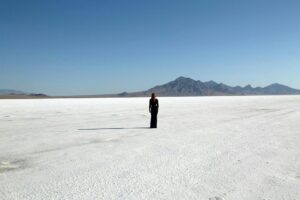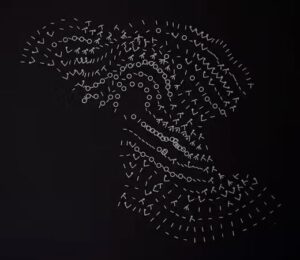
I’m an artist using scientific data as an artistic medium − here’s how I make meaning
As an artist working across media, I’ve used everything from thread to my voice to poetically translate and express information. Recently, I’ve been working with another medium – geologic datasets. While scientists use data visualization to show the results of a dataset in interesting and informative ways, my goal as an artist is a little different. In the studio, I treat geologic data as another material, using it to guide my interactions with Mylar film, knitting patterns or opera. Data, in my work, functions expressively and abstractly. Two of my projects in particular, “points of rupture” and “tidal arias,” exemplify this way of working. In these pieces, my goal is to offer new ways for people to personally relate to the immense scale of geologic time.

Points of rupture
An early project in which I treated data as a medium was my letterpress print series “points of rupture.” In this series, I encoded data from cryoseismic, or ice quake, events to create knitting patterns. Working with ice quake data was a continuation of my research into what I call “archived landscapes.” These are places that have had multiple distinct geologic identities over time, like mountains that were once sea reefs. Because knit textiles are made up of many individual stitches, I can use them to encode discrete data points. In a knitting pattern, or chart, each kind of stitch is represented by a specific symbol. I used the open-source program Stitch Maps to write the patterns for this project, translating the peaks and valleys of seismographs into individual stitch symbols. Knitting charts typically display these symbols in a grid. Instead, Stitch Maps allows them to fall as they would when knitted, so the chart mimics the shape of the final textile.
I was drawn to the expressive possibilities of this feature and how the software allowed me to experiment. I was able to write patterns that worked only in theory and not as physical, handmade structures. This gave me more freedom to design patterns that fully expressed the datasets without having to ensure their viability as textiles. Glaciers form incrementally as new snowfall compacts previous layers of snow, crystallizing them into ice. A knitted fabric similarly accumulates in layers, as rows of interlocking loops. Each structure appears stable but could easily be dissolved. Ice quakes occur in glaciers as a result of calving events or pooling meltwater. Like melting glaciers, knitting is always in danger of coming apart – but instead of melting, by snagging and unraveling into formlessness. These structural similarities between glaciers and knitting are reflected in the “points of rupture” prints, where disruptive ice quakes translate into unknittable patterns.

The loop
Repeated, interlocking loops are the base units that compose the structure of a knitted textile. The loop also forms the seed of an in-progress work I pursued during an artist residency with the NASA GEODES research group. I joined their research team in Flagstaff, Arizona, in August 2023. I assisted in gathering data from sites within the San Francisco volcanic field, while also conducting my own fieldwork: photography, drawing, note-taking and walking. One of my walks was a trek around a particularly prominent geologic loop – the rim of the S P cinder cone volcano. This is the second crater walk I’ve completed, the first being a tracing of the subsurface rim of the Decorah impact structure in Iowa. I see my paths through these landscapes as stand-ins for yarn. Over time, by taking walks that trace craters, or geologic loops, I will perform a textile. The performance of something as familiar as a textile offers me a new way to think about something that is much more difficult to comprehend – geologic time.
Reprinted from a The Conversation article by Sarah Nance
